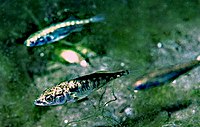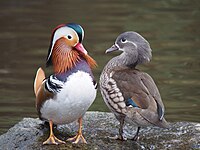
Recursive use of home ranges and seasonal shifts in foraging behavior by a generalist carnivore
Sign Up to like & getrecommendations! Published in 2022 at "Ecology and Evolution"
DOI: 10.1002/ece3.9540
Abstract: Abstract Coyotes (Canis latrans) colonized the southeastern United States over the last century as large predators, including the red wolf (Canis rufus) and eastern cougar (Puma concolor), were extirpated from the region. As a generalist… read more here.
Keywords: generalist carnivore; foraging behavior; home; resident coyotes ... See more keywords

Lower nutritional state and foraging success in an Arctic seabird despite behaviorally flexible responses to environmental change
Sign Up to like & getrecommendations! Published in 2023 at "Ecology and Evolution"
DOI: 10.1002/ece3.9923
Abstract: Abstract The degree to which individuals adjust foraging behavior in response to environmental variability can impact foraging success, leading to downstream impacts on fitness and population dynamics. We examined the foraging flexibility, average daily energy… read more here.
Keywords: nutritional state; foraging behavior; foraging success; success ... See more keywords

Behavioral niche partitioning reexamined: Do behavioral differences predict dietary differences in warblers?
Sign Up to like & getrecommendations! Published in 2020 at "Ecology"
DOI: 10.1002/ecy.3077
Abstract: Behavioral niche partitioning is an important and widely assumed mechanism for the coexistence of ecologically similar species. Here we assessed this mechanism by testing its core assumption, that evolved differences in foraging behavior correspond with… read more here.
Keywords: coexistence; behavioral niche; dietary differences; foraging behavior ... See more keywords

Mercury Exposure and Habitat Fragmentation Affect the Movement, Foraging Behavior and Search Efficiency of the Marsh Periwinkle (Littorina Irrorata).
Sign Up to like & getrecommendations! Published in 2022 at "Environmental toxicology and chemistry"
DOI: 10.1002/etc.5545
Abstract: The interactions between habitat fragmentation and other stressors are considered a key knowledge gap. This work tested the hypotheses that mercury enhances the effects of fragmentation by (i) reducing the cumulative daily movement of organisms,… read more here.
Keywords: foraging behavior; search efficiency; movement; fragmentation ... See more keywords

Sociodemographic variation in foraging behavior and the adaptive significance of worker production in the facultatively social small carpenter bee, Ceratina calcarata
Sign Up to like & getrecommendations! Published in 2017 at "Behavioral Ecology and Sociobiology"
DOI: 10.1007/s00265-017-2365-6
Abstract: Provisioning for young offspring is an archetypical form of parental investment. Ceratina calcarata bees provide extended maternal care to their young and demonstrate an unusual strategy of dual-phase pollen provisioning. Most bees first gather provisions… read more here.
Keywords: ceratina calcarata; investment; foraging behavior; significance ... See more keywords

The development and maintenance of sex differences in dietary breadth and complexity in Bornean orangutans
Sign Up to like & getrecommendations! Published in 2021 at "Behavioral Ecology and Sociobiology"
DOI: 10.1007/s00265-021-03014-3
Abstract: Abstract Orangutans show a pronounced sexual dimorphism, with flanged males (i.e., males with fully grown secondary sexual characteristics) reaching twice the size of adult females. Furthermore, adult orangutans show sex-specific dispersal and activity patterns. This… read more here.
Keywords: sex differences; bornean orangutans; sex; foraging behavior ... See more keywords

Sphaerophoria rueppelli adults change their foraging behavior after mating but maintain the same preferences to flower traits
Sign Up to like & getrecommendations! Published in 2019 at "BioControl"
DOI: 10.1007/s10526-019-09928-2
Abstract: Hoverflies can play an important role in aphid biological control. Adult hoverflies depend on pollen and nectar to survive. Therefore the placement of flower resources in agroecosystems is a common method to enhance the populations… read more here.
Keywords: flower traits; insects; sphaerophoria rueppelli; foraging behavior ... See more keywords

Foraging behavior of yellow-phase Japanese eels between connected fresh- and brackish water habitats
Sign Up to like & getrecommendations! Published in 2020 at "Environmental Biology of Fishes"
DOI: 10.1007/s10641-020-01002-6
Abstract: Japanese eels (Anguilla japonica) utilize a broad range of habitats along the marine-freshwater ecotone during their growth phase in inland waters. This study aimed to analyze the foraging behavior of yellow-phase Japanese eels in connected… read more here.
Keywords: fresh brackish; brackish water; foraging behavior; japanese eels ... See more keywords

Root-foraging behavior ensures the integrated growth of Vallisneria natans in heterogeneous sediments
Sign Up to like & getrecommendations! Published in 2017 at "Environmental Science and Pollution Research"
DOI: 10.1007/s11356-017-8473-z
Abstract: The present study was carried out to determine the efficacy of root foraging and the physiological response of Vallisnaria natans grown in heterogeneous sediments. V. natans was cultivated in two homogeneous and two heterogeneous sediments.… read more here.
Keywords: heterogeneous sediments; root foraging; foraging behavior; behavior ensures ... See more keywords

Environmental Programming of Adult Foraging Behavior in C. elegans
Sign Up to like & getrecommendations! Published in 2019 at "Current Biology"
DOI: 10.1016/j.cub.2019.07.045
Abstract: Foraging strategies should be tuned to the expected distribution of resources in the environment. Tuning can occur over generations and lead to genetic differences in innate foraging behavior or over shorter timescales within an individual's… read more here.
Keywords: environmental programming; behavior elegans; adult foraging; foraging behavior ... See more keywords

Behavior, size, and body condition predict susceptibility to management and reflect post-treatment frequency shifts in an invasive snake
Sign Up to like & getrecommendations! Published in 2020 at "Global Ecology and Conservation"
DOI: 10.1016/j.gecco.2019.e00834
Abstract: Abstract Foraging behavior can have population-level effects that are of interest for wildlife management. For invasive species, foraging behavior has been tied to establishment ability and rate of spread and is generally of import in… read more here.
Keywords: control; size; foraging behavior; body condition ... See more keywords